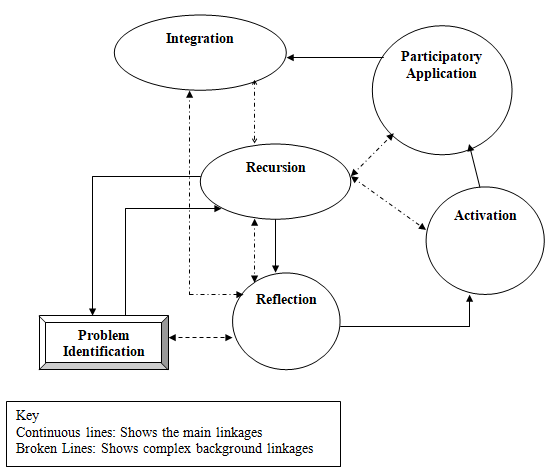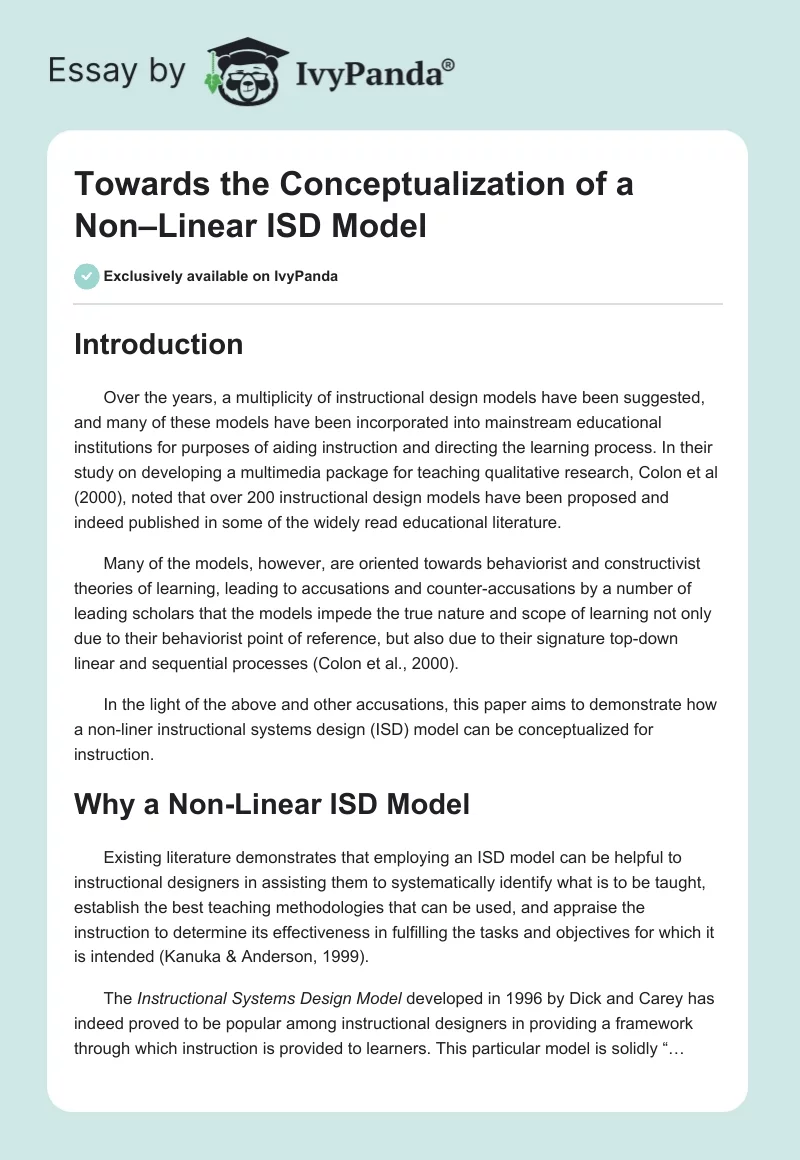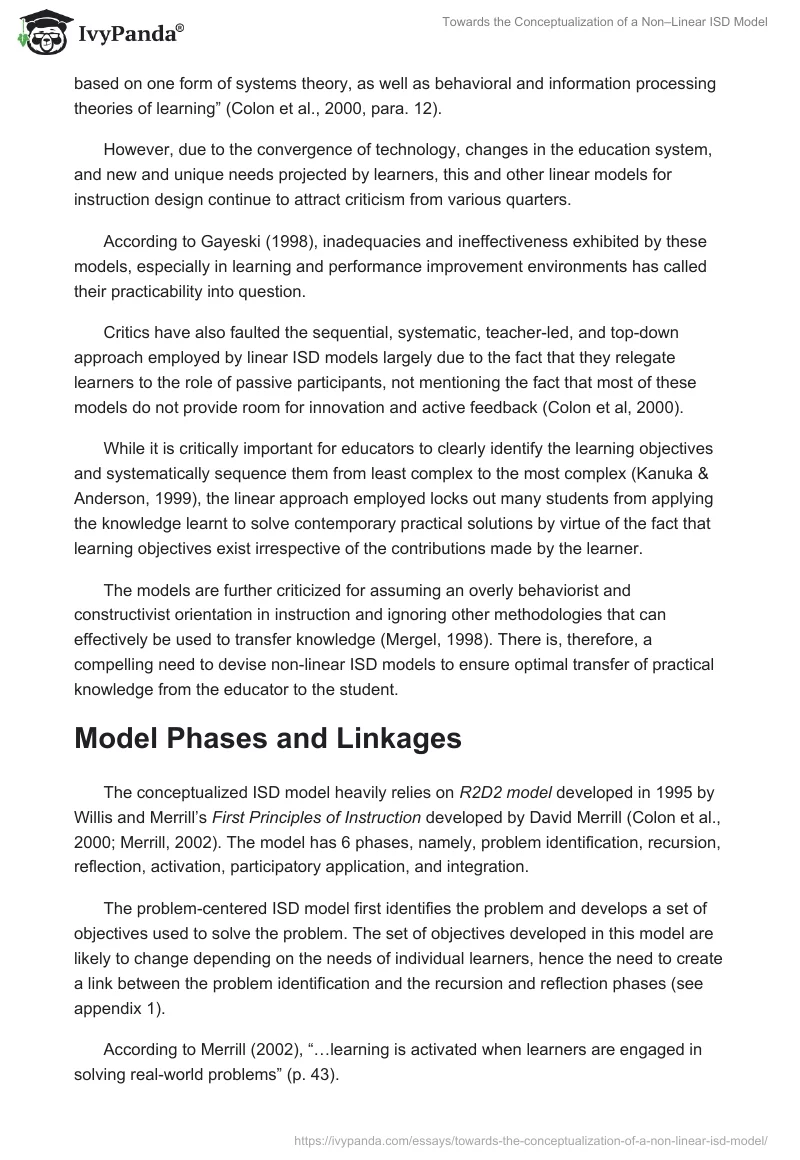Introduction
Over the years, a multiplicity of instructional design models have been suggested, and many of these models have been incorporated into mainstream educational institutions for purposes of aiding instruction and directing the learning process. In their study on developing a multimedia package for teaching qualitative research, Colon et al (2000), noted that over 200 instructional design models have been proposed and indeed published in some of the widely read educational literature.
Many of the models, however, are oriented towards behaviorist and constructivist theories of learning, leading to accusations and counter-accusations by a number of leading scholars that the models impede the true nature and scope of learning not only due to their behaviorist point of reference, but also due to their signature top-down linear and sequential processes (Colon et al., 2000). In the light of the above and other accusations, this paper aims to demonstrate how a non-liner instructional systems design (ISD) model can be conceptualized for instruction.
Why a Non-Linear ISD Model
Existing literature demonstrates that employing an ISD model can be helpful to instructional designers in assisting them to systematically identify what is to be taught, establish the best teaching methodologies that can be used, and appraise the instruction to determine its effectiveness in fulfilling the tasks and objectives for which it is intended (Kanuka & Anderson, 1999).
The Instructional Systems Design Model developed in 1996 by Dick and Carey has indeed proved to be popular among instructional designers in providing a framework through which instruction is provided to learners. This particular model is solidly “…based on one form of systems theory, as well as behavioral and information processing theories of learning” (Colon et al., 2000, para. 12).
However, due to the convergence of technology, changes in the education system, and new and unique needs projected by learners, this and other linear models for instruction design continue to attract criticism from various quarters.
According to Gayeski (1998), inadequacies and ineffectiveness exhibited by these models, especially in learning and performance improvement environments has called their practicability into question. Critics have also faulted the sequential, systematic, teacher-led, and top-down approach employed by linear ISD models largely due to the fact that they relegate learners to the role of passive participants, not mentioning the fact that most of these models do not provide room for innovation and active feedback (Colon et al, 2000).
While it is critically important for educators to clearly identify the learning objectives and systematically sequence them from least complex to the most complex (Kanuka & Anderson, 1999), the linear approach employed locks out many students from applying the knowledge learnt to solve contemporary practical solutions by virtue of the fact that learning objectives exist irrespective of the contributions made by the learner.
The models are further criticized for assuming an overly behaviorist and constructivist orientation in instruction and ignoring other methodologies that can effectively be used to transfer knowledge (Mergel, 1998). There is, therefore, a compelling need to devise non-linear ISD models to ensure optimal transfer of practical knowledge from the educator to the student.
Model Phases and Linkages
The conceptualized ISD model heavily relies on R2D2 model developed in 1995 by Willis and Merrill’s First Principles of Instruction developed by David Merrill (Colon et al., 2000; Merrill, 2002). The model has 6 phases, namely, problem identification, recursion, reflection, activation, participatory application, and integration.
The problem-centered ISD model first identifies the problem and develops a set of objectives used to solve the problem. The set of objectives developed in this model are likely to change depending on the needs of individual learners, hence the need to create a link between the problem identification and the recursion and reflection phases (Figure 1).

According to Merrill (2002), “…learning is activated when learners are engaged in solving real-world problems” (p. 43). The recursion phase will aim to specifically allow instruction designers and learners to revisit any phase included in the model to make refinements, corrections, and revisions as deemed necessary. This will actively promote the learning process in addition to ensuring holistic integration of new knowledge by the learners. This phase is also linked to problem identification phase, reflection phase and integration phase.
The next phase – reflection – is intended to emphasize the need for the instruction designers to considerately inquire about feedback and other arising notions from other sources, including the learners’ own perceptions, worldviews and level of understanding (Cohen et al., 2000). Further on, activation phase will take cognizance of the fact that “learning is promoted when relevant previous experience is activated” (Merrill, 2002, p. 46).
Many learners have had many previous experiences that may relate to the task at hand and, as such, relevant information should be activated by going back to the reflection phase to ensure this information is elicited for use as groundwork for learning new knowledge.
The participatory application phase is where real learning takes place. This phase takes note of the fact that it is the learners who will utilize the knowledge transferred by educators, and they must therefore be active participants in the learning process (Cohen et al., 2002).
As such, this phase will also be linked with other phases such as problem identification and reflection to guarantee the involvement of learners. In this phase, educators must develop frameworks aimed at ensuring that learning process is consistent with the identified methodologies of solving the problem, and that learners have the capacity to utilize the new knowledge in solving practical problems.
The integration phase will focus on ensuring that learners have the capacity to integrate the knowledge transferred by the educators to solve their everyday problems (Merrill, 2002). This phase will also be linked with reflection and recursion phases to ensure all arising queries from the learners are adequately attended to.
Model Outputs
The outputs for problem identification phase include the objectives and the methodologies that will be used to solve the underlying problem. The recursion phase will generate problem refinements, corrections, and revisions as may be deemed necessary. The reflection phase will generate feedback from instructors and students, and learners’ perceptions and worldviews concerning the problem at hand.
The activation phase will aim to come up with quantifiable measures that can be used to evaluate the capacity of learners to grasp and relate to the problem at hand, while the participatory application phase will generate the actual results of the learning process, including how the learner has understood the problem and if there is need to make clarifications.
The outputs arising from the integration phase include the practical demonstration by learners on how they can use the knowledge learnt to solve real-life problems, and the capacity by learners to link the knowledge learnt to other life experiences.
Structure of Model
The model utilizes a non-linear structure to avoid the many problems associated with linear ISD models. This particular model realizes that different problems may call for diverse starting points, and new objectives may indeed emerge over the design process (Cohen et al., 2002). As such, it is important to create mechanisms for adequately address arising issues that are largely ignored in linear models.
Conclusion
The need to conceptualize and develop a non-linear ISD model is very much informed by the urge to come up with practical solutions to the many challenges facing instruction especially in contemporary times. Learners need to be assisted to solve practical solutions using an instruction strategy that is responsive to their needs, and that realizes their participation is important for effective learning to take place.
In addition, the complex nature of modern problems and instruction have rendered most linear ISD models ineffective due to entrenched limitations in scope and practicability in offering an instruction methodology that can assist learners to relate what has been learned to real-life experiences (Merrill, 2002). The conceptualized non-linear ISD model will not only ensure that learners can use new knowledge to solve practical issues, but it will avail platforms for recursion and participatory application.
References
Colon, B., Taylor, K.N., & Willis, J. (2000). Constructivist instructional design: Creating a multimedia package for teaching critical research. The Qualitative Research, 5(1-2). Web.
Gayeski, D.M. (1998). Out-of-the box instructional design: Moving from assembly-line models to non-linear performance models. Web.
Kanuka, H., & Anderson, T. (1999). Using constructivism in Technology-Mediated Learning: Constructing the Order out of the Chaos in the Literature. Web.
Mergel, B. (1998). Instructional Design & Learning Theory. Web.
Merrill, M.D. (2002). First principles of Instruction. ETR&D, 50(3), 43-59. Web.


